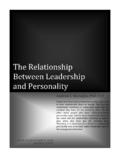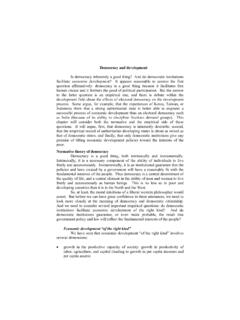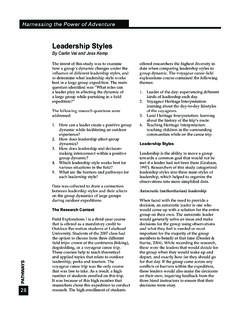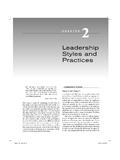Transcription of Excellence Theory in Public Relations
1 Excellence Theory in Public Relations 1 Blackwell Publishing LtdOxford, UKICAEThe International Encyclopedia of Communication9781405131995 2008 Blackwell Publishing LtdAugust 200700??????Original ArticlesExcellence Theory in Public RelationsExcellence Theory in Public Relations Excellence Theory in Public Relations James E. Grunig University of Maryland The Excellence Theory is a general Theory of Public Relations that resulted from a 15-yearstudy of best practices in communication management funded by the InternationalAssociation of Business Communicators (IABC) Research Foundation. Three books werepublished from the research (J. E. Grunig 1992; Dozier et al. 1995; L. A. Grunig et ). This general Theory incorporates a number of middle-range theories of publicrelations, including theories of publics, Public Relations and strategic management,models of Public Relations , evaluation of Public Relations , employee communication, publicrelations roles, gender, diversity, power, activism, ethics and social responsibility, andglobal Public Relations ( Public Relations Evaluation).
2 The Theory was tested throughsurvey research of heads of Public Relations , CEOs, and employees in 327 organizations(corporations, nonprofit organizations, government agencies, and associations) in theUnited States, Canada, and the United Kingdom ( Survey; Interview). The survey researchwas followed by qualitative interviews with heads of Public Relations , other publicrelations practitioners, and CEOs in 25 organizations with the highest and lowest scoreson a scale of Excellence produced by statistical analysis of the survey data ( Interview,Qualitative).The Excellence Theory first explained the value of Public Relations to organizations andsociety based on the social responsibility of managerial decisions and the quality ofrelationships with stakeholder publics. For an organization to be effective, according tothe Theory , it must behave in ways that solve the problems and satisfy the goals ofstakeholders as well as of management ( Stakeholder Theory ).
3 If it does not, stakeholderswill either pressure the organization to change or oppose it in ways that add cost and riskto organizational policies and decisions. To behave in socially acceptable ways, organiza-tions must scan their environment to identify publics who are affected by potentialorganizational decisions or who want organizations to make decisions to solve problemsthat are important to them. Then, organizations must communicate symmetrically withpublics (taking the interests of both the organization and publics into account) tocultivate high-quality, long-term relationships with them. The interviews with CEOs andsenior Public Relations officers revealed that good relationships were of value toorganizations because they reduced the costs of litigation, regulation, legislation, andnegative publicity caused by poor relationships; reduced the risk of making decisions thataffect different stakeholders; or increased revenue by providing products and servicesneeded by on this theoretical premise about the value of Public Relations , the excellencetheory derived principles of how the function should be organized to maximize this , the research showed that involvement in strategic management was the criticalcharacteristic of excellent Public Relations .
4 Public Relations executives played a strategicmanagerial role as well as administrative manager role. Public Relations also was empoweredby having access to key organizational decision-makers (the dominant coalition). 2 Excellence Theory in Public Relations Second, the study showed that Public Relations loses its unique role in strategicmanagement if it is sublimated to marketing or other management functions. Sublima-tion to another function resulted in attention only to the stakeholder category of interestto that function, such as consumers for marketing. Sublimation to marketing also usuallyresulted in asymmetrical communication. An excellent Public Relations function was integrated , however. Programs for different stakeholders were gathered into a singledepartment or coordinated through a senior vice president of corporate excellent Public Relations function did work with other management functions to helpthem build relationships with relevant , the Excellence study showed that a symmetrical system of internal commun-ication increased employees satisfaction with their jobs and with the , internal communication generally was not practiced unless organizations had aparticipative rather than authoritarian culture and a decentralized, less stratified(organic) structure rather than a centralized, stratified (mechanical) , the Excellence study examined the effect of the growing number of women inpublic Relations and evidence that women had difficulty entering managerial roles.
5 Theresearch showed that organizations with excellent Public Relations valued women as muchas men for the strategic role and developed programs to empower women throughout theorganization. The emphasis on gender also led to inclusion of diversity of race andethnicity as a fifth part of the Excellence Theory . This focus, along with the internationalnature of the project, expanded the Theory to make it appropriate for use outside theUnited States in diverse cultural, political, and economic contexts. Replication of thestudy in Slovenia (L. A. Grunig et al. 1998) showed that the Excellence Theory is generic tomany contexts, as long as the Theory is applied differently when contextual variables aredifferent. The research in Slovenia also resulted in the addition of ethics to the excellencetheory a sixth component ( Public Relations Ethics).Since the completion of the Excellence study, scholars in this research tradition havecontinued to improve and enlarge the Theory by conducting research to help publicrelations professionals participate in strategic decision processes.
6 This research has beenon environmental scanning and publics, scenario building, empowerment of publicrelations, ethics, relationships, the return-on-investment of Public Relations , evaluation,relationship cultivation strategies, conflict resolution, complexity Theory , specializedareas of Public Relations , and global strategy (J. E. Grunig 2006; Toth 2007).SEE ALSO: Consensus-Oriented Public Relations Interview Interview, Qualita-tive Organization Public Relationships Public Relations Public Relations Ethics Public Relations Evaluation Public Relations : Global Firms Public RelationsPlanning Public Relations Roles Publics: Situational Theory Stakeholder Theory Survey References and Suggested Readings Dozier, D. M., with Grunig, L. A., & Grunig, J. E. (1995). Manager s guide to Excellence in publicrelations and communication management.
7 Mahwah, NJ: Lawrence Erlbaum. Excellence Theory in Public Relations 3 Grunig, J. E. (ed.) (1992). Excellence in Public Relations and communication management . Hillsdale,NJ: Lawrence , J. E. (2006). Furnishing the edifice: Ongoing research on Public Relations as a strategicmanagement function. Journal of Public Relations Research , 18, 151 , L. A., Grunig, J. E., & Ver c i c , D. (1998). Are the IABC s Excellence principles generic?Comparing Slovenia and the United States, the United Kingdom and Canada. Journal ofCommunication Management , 2, 335 , L. A., Grunig, J. E., & Dozier, D. M. (2002). Excellent Public Relations and effective organizations:A study of communication management in three countries . Mahwah, NJ: Lawrence , E. L. (ed.) (2007). The future of Excellence in Public Relations and communication management .Mahwah, NJ: Lawrence Erlbaum.






